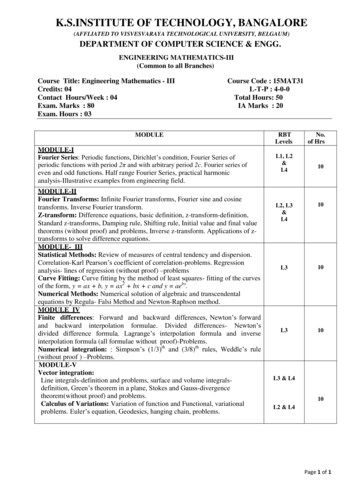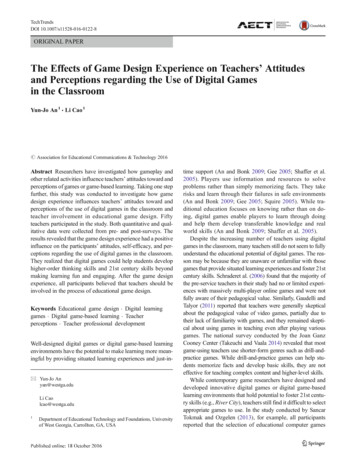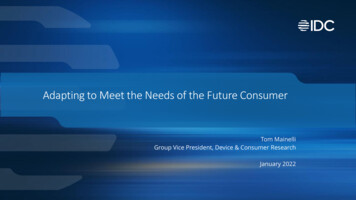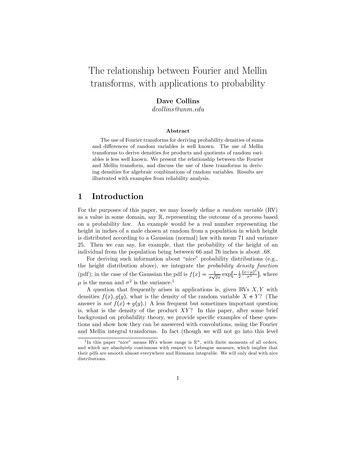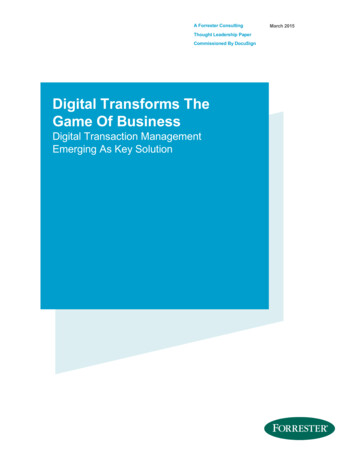
Transcription
A Forrester ConsultingThought Leadership PaperCommissioned By DocuSignDigital Transforms TheGame Of BusinessDigital Transaction ManagementEmerging As Key SolutionMarch 2015
Table of ContentsExecutive Summary . 1Digital Technologies Transform The Game Of Business . 2Digital Transaction Management Offers New Benefits To Businesses . 3So What’s The Big Deal With Digital? . 4What Can Your Business Digitize? . 6Key Recommendations . 8Appendix A: Methodology . 9Appendix B: Endnotes . 9ABOUT FORRESTER CONSULTINGForrester Consulting provides independent and objective research-basedconsulting to help leaders succeed in their organizations. Ranging in scope from ashort strategy session to custom projects, Forrester’s Consulting services connectyou directly with research analysts who apply expert insight to your specificbusiness challenges. For more information, visit forrester.com/consulting. 2015, Forrester Research, Inc. All rights reserved. Unauthorized reproduction is strictly prohibited.Information is based on best available resources. Opinions reflect judgment at the time and are subject tochange. Forrester , Technographics , Forrester Wave, RoleView, TechRadar, and Total Economic Impactare trademarks of Forrester Research, Inc. All other trademarks are the property of their respectivecompanies. For additional information, go to www.forrester.com. [1-RIY78L]
1Executive SummaryNo one really doubts the importance of digitaltransformation to today's businesses. Our global surveyfound that few can deny the mounting internal and externalpressure to do more than pay lip service to digital. Yet,digital adoption is not achieved without changing thebehavior of the business. Management must be convincedof the business case, a thorough implementation plan mustbe in place, and enterprises must alter and revamp internalprocesses, technology, and staff to make the digitaltransformation.In October 2014, DocuSign commissioned ForresterConsulting to dive deeply into the issues enterprises face indigitizing their businesses by evaluating the role of digitaltransaction management (DTM). We wanted to see whetherand to what extent DTM is emerging as an importantsolution for enterprises to embrace.How important is DTM? What are its benefits? Howsignificant are they? What are the roadblocks organizationsface in enabling digital transactions? Does digitizingbusiness fundamentally change the dynamics of themarkets in which companies operate?Eighty-three percent of IT and LOB decisionmakers have expressed a need for a DTMsolution for their enterprise.KEY FINDINGSIn conducting a 400-person online survey as well as fivequalitative interviews of IT and line-of-business (LOB)decision-makers from North America, Europe, and APACwith responsibility for document-intensive businessprocesses and selecting and managing transactionaltechnologies, Forrester determined that:›Decision-makers understand the importance of digitaltechnologies and what DTM means. Digital hastransformed the ways in which customers discover,explore, buy, and engage with products and services.Ninety-three percent of IT leaders and 76% of LOBleaders acknowledged that providing a DTM experience isimportant to the success of their businesses.›The need for DTM is evident. Enterprises understanddigital transaction management. The link to customerexperience and embedded user acknowledgement in thetransaction separate DTM from previous automationapproaches. Nearly eight in 10 IT and LOB decisionmakers recognize a clear need for a DTM solution.›Lines of business are losing significant revenue dueto poor transaction management. Our surveyrespondents were able to quantify the challengesassociated with traditional analog processes: A reported20% of companies estimated that 6% to 10% of revenueis lost, while 37% of companies estimated that number tobe in the 11% to 25% range.›Operational processes are the DTM sweet spot. DTMshows tangible customer benefits, but the primary valueproposition is rooted in helping enterprises achieveoperational excellence. Decision-makers are mostinterested in digitizing operational processes and postsales transactions.
2Digital Technologies Transform TheGame Of BusinessAs a business leader, do you get the feeling that you're nolonger playing the same game that you once were? It's notyou; the world has changed. The things that used to setcompanies apart — such as economies of scale, distributionstrength, and brand — are far less potent than they used tobe. Why? Because digital technology has fundamentallychanged two things: the dynamics of the markets in whichyou operate and the speed needed to remain competitive.››Your customers are digital. Forrester projects that by2017, 74% of the US adult online population will own1smartphones, and 46% will own tablets. Digital hastransformed the ways in which customers discover,explore, buy, and engage with products and services,allowing them to transcend traditional channelboundaries. Digital disruptors challenge your businessmodel as they engage your customers in new ways.Enterprises seek to connect with customers throughdigital technologies. Sixty-three percent of IT and LOBdecision-makers claimed that their organization is at leasta 7 out of 10 on the digital versus analog spectrum. Inaddition, they recognize that digital technologies createopportunities to add new services to physical products,opening doors to new experiences and revenue streams.This comes as no surprise, as 76% of IT and 93% of LOBdecision-makers feel that a digital experience is importantto their enterprise (see Figure 1).“We see real tangible results [fromthese programs] in terms of winningbusiness for us.”— Senior manager at a US-based brokerageFIGURE 1IT And LOB Decision-Makers Feel Strongly AboutThe Need For A Digital Experience“How important to your enterprise is providing aDTM experience — e.g., remaining digital in all ofyour interactions and transactions?”32%Very important44%47%ImportantSomewhat importantNot that important46%20%6%3%1%LOBITNot important at all 1%0%Base: 400 IT and LOB leaders in the US, Canada, Brazil, the UK,France, Germany, Australia, and Japan at enterprises with more than500 employeesSource: A commissioned study conducted by Forrester Consulting onbehalf of DocuSign, December 2014
3Digital Transaction ManagementOffers New Benefits To Businessesthe value is — the bottleneck where the client actually clicksand submits the paperwork to us." Our study found that:›Digital transaction management is defined as: “A newcategory of cloud services designed to digitally managedocument-based transactions. DTM removes the frictioninherent in transactions that involve people, documents, anddata to create faster, easier, more convenient, and secureprocesses.”Enterprise interviewees understood the concept and wereable to contrast DTM with previous automation approaches.According to a senior manager at a leading brokeragehouse: ”DTM is different than traditional transactionautomation. It is definitely something that is new and anevolution of previous automation approaches. The keydifference of DTM is that it is customer facing. That’s whereDecision-makers acknowledge the need for a DTMsolution. For many organizations, document-centrictransactions start with paper, e-form, PDF, fax, or emailwith attendant printing, faxing, and scanning. Theseprocesses are time- and labor-intensive and often involveovernighting documents to get an acknowledgement orcomplete a transaction. As a senior manager at abrokerage company told us: “Before we digitized it wasbad. The front end (collecting data from customers) waspredominantly fax and snail mail and the back end was alot of re-imaging work and a lot of data manipulation.Purely analog and very inefficient. The move to a digitaltransaction was a big hit for our advisors — a no-brainerfor them. They can get an audit trail — basically anFIGURE 2Despite A Sense That Their Organization Is Trending Toward Digital Processes, 83% Of Decision-MakersAcknowledge A Need For A DTM Solution“When thinking about DTM in regards to the documents used at your company, where would you say your firmis on a fully analog to fully digital spectrum?”Fully digital 106%910%821%726%610%47%325%2%Fully paper-based 1 0%Is a definition that doesnot make sense to meDefines a pressing1%need in my enterprise notDefines a clear need thataddressed well by existing is addressed completelytechnology solutionsby existing technology28%16%83% acknowledge aneed for a DTM solutionat their enterprise13%5“Regarding the definition of DTM, please select thestatement that best applies to you.”63% report to beat least 7/10 digitalDefines a clear need in myenterprise that is only partiallyaddressed by existing solutions55%Digital transaction management (DTM) is defined as “a new category ofcloud services designed to digitally manage document-basedtransactions. DTM removes the friction inherent in transactions thatinvolve people, documents, and data to create faster, easier,more convenient, and secure processes.”Base: 400 IT and LOB leaders in the US, Canada, Brazil, the UK, France, Germany, Australia, and Japan at enterprises with more than 500 employeesSource: A commissioned study conducted by Forrester Consulting on behalf of DocuSign, December 2014
4integrated set of data — and fund the account muchfaster.” Despite the explosion in consumer technology,most enterprises still require the basic blocking andtackling that digital technologies provide. Despite a sensethat their organizations are trending toward digitalprocesses, 83% of IT and LOB decision-makersacknowledge a clear/pressing need for a DTM solution,as defined above, that is either not addressed or onlypartially addressed by their existing solutions (see Figure2).›IT decision-makers perceive a higher level of digitaladoption than do LOB decision-makers. We askedwhere firms were on a spectrum from fully analog (paperand manual processes) to fully digital, and we obtainedsome interesting results. For one, as expected, most firmshave a relatively high rate of digital automation in currentprocesses (see Figure 3). But they still view 30% to 42%of their processes as being poorly digitized, depending onwho we asked. This proportion of analog processesaccounts for as much as 80% of costs and inefficienciesin their transactions, placing a significant burden onenterprises. Interestingly, IT management had a brighterview of the rate of digitization, perhaps reflecting theirhard work and focus to automate processes. LOB, incontrast, felt there was far more work to do (see Figure 3).IT management also felt it was more important to presenta DTM experience (a more modern experience) to theircustomer than was recognized by their LOB counterparts.So What’s The Big Deal With Digital?›Digitization drives efficiency. Eliminating costs, makingfaster changes, and improving customer experience arestrong business drivers to move your enterprise towardDTM. In order to gauge the importance of these drivers,we asked our respondents what issues and problemsthey encounter with their analog processes. Respondentsidentified human error as the top issue encountered withtheir analog processes. Additional issues includedcumbersome paper-oriented document management,collecting and managing documents from multiplesources, administering and controlling documents overtime, dealing with a lack of security, and maintainingvisibility (see Figure 4).FIGURE 3IT Decision-Makers Perceive A SignificantlyHigher Level Of Digital Adoption Than Do LOBDecision-Makers“When thinking about DTM in regards to the documentsused at your company, where would you say your firmis on a fully analog to fully digital spectrum?”Fully paper-based (1)-48%(5-6)20%7-Fullydigital (10)71%ITFully paper-based (1)-417%7-Fullydigital (10)58%(5-6)25%LOBBase: 400 IT and LOB leaders in the US, Canada, Brazil, the UK,France, Germany, Australia, and Japan at enterprises with more than500 employees(percentages may not total 100 because of rounding)Source: A commissioned study conducted by Forrester Consulting onbehalf of DocuSign, December 2014“By taking on DTM, we were able to increase thevolume of processing without adding heads. Sothere's the DTM value: cost, productivity, and cycletime.”— Senior director at a US-based computer software,hardware, and consumer electronicsorganization
5FIGURE 4Human Error Is The Top Issue Encountered WithAnalog ProcessesFIGURE 5LOB Is Losing Significant Revenue“Using your best estimate, what percentage of revenueis lost due to poor transaction management?”“Which of the following process and systems issues doyou encounter with your analog processes?”(Select all that apply)Errors due to humans andanalog processesCumbersome paper-orientedtasks such as scanning anddocument managementDifficulty collecting and managingdocuments from multiple sourcesDifficulty administering andcontrolling documents over timeLack of security overprinted documentsDifficulty maintaining visibilityinto the location and status ofpaper-based documentsMore than 50%50%41% to 45%2%36% to 40% 1%44%42%31% to 35%5%26% to 30%4%21% to 25%39%11%16% to 20%13%11% to 15%13%6% to 10%37%20%1% to 5%None34%Source: A commissioned study conducted by Forrester Consulting onbehalf of DocuSign, December 2014Poor transaction management contributes directly torevenue loss. All of the above challenges identified byour respondents affect the bottom line. Ninety-eightpercent of companies reported some revenue impact ofpoor transaction management. A reported 20% ofcompanies estimated that 6% to 10% of revenue is lost,while 37% of companies estimated that number to be inthe 11% to 25% range (see Figure 5). Revenue hits comein the form of lost deals, prospects that abandononboarding processes, disjointed experiences that createpoor customer satisfaction, and lost business due to thelack of self-service and direct-to-consumer digitalplatforms. As a median, LOB decision-makers estimatedthat they are losing 11% to 15% of deals due to poortransaction management.“The digital solutions that we have put into place andtracked have seen the ROI that we anticipated, andin some cases, more than we anticipated.”— Senior director at a US-based computer software,hardware, and consumer electronicsorganization9%2%Base: 400 IT and LOB leaders in the US, Canada, Brazil, the UK,France, Germany, Australia, and Japan at enterprises with more than500 employeesBase: 400 IT and LOB leaders in the US, Canada, Brazil, the UK, France,Germany, Australia, and Japan at enterprises with more than 500employees›2%46% to 50% 1%(percentages may not total 100 because of rounding)›Costs and lack of skills are primary barriers todigitization. The advantages of DTM are wellunderstood, so why are enterprises so slow to digitizetransactions? Respondents ranked security as by far thetop concern when considering adopting and growing aDTM solution — 81% of respondents ranked securityamong their top three concerns. Compliance and privacywere next on the list. No surprises there, as seeminglyevery day the media reports yet another violation of dataprivacy. But when our respondents were asked about theroadblocks to enabling digital transactions, they said thatthe real barriers going forward are cost concerns and alack of digital skill sets. Forty-five percent of decisionmakers identified a lack of skills and 39% identified costsassociated with retooling processes as the top roadblocksto enabling digital transactions (see Figure 6).
6FIGURE 6Skills And The Costs Associated WithRetooling Processes Are The Top RoadblocksTo Digitization“What are (or would be) the top business drivers for movingyour enterprise to digital transaction management?”(Please rank up to three)“What are the top roadblocks to enablingdigital transactions?”(Select all that apply)Lack of skills to implement/managedigital transaction systemsRank 145%Cost to retool processesis too high39%Lack of available technology36%Lack of vision/desire to do so35%Our customers or other stakeholdersprefer paper transactionsWe have not experienced and/ordo not anticipate any roadblocksto enabling digital transactionsFIGURE 7Efficiency, Security, And Customer ExperienceAre Top Drivers For DTM27%5%Base: 400 IT and LOB leaders in the US, Canada, Brazil, the UK,France, Germany, Australia, and Japan at enterprises with more than500 employeesSource: A commissioned study conducted by Forrester Consultingon behalf of DocuSign, December 2014Rank 2Rank 3Improve efficiency (such aseliminating costs associated with41% 18% 15%paper-based transactions)Improve security and compliance withclearer tracking and monitoring of 12% 24%30%documents and approvalsImprove customer experience withfaster access to documents and 20%22% 15%a more streamlined experienceProvide greater agility (such as theability to make changes faster) 17% 14%12%Accelerate revenue (reduce transactioncycle time and close business faster)7%15% 14%3%Improve business insightthrough reporting and analytics 7%14%Base: 400 IT and LOB leaders in the US, Canada, Brazil, the UK,France, Germany, Australia, and Japan at enterprises with more than500 employeesSource: A commissioned study conducted by Forrester Consulting onbehalf of DocuSign, December 2014What Can Your Business Digitize?Sales, HR, finance, order processing, legal, procurement,and field service are all great focal spots for expanding yourcompany’s use of DTM. They remain mired in paper andanalog processes. Enterprises see the value — animportant first step — but execution is the hard part.Implementing human changes in the organization andrevising technology that supports core processes challengeexecutives.›Efficiency, security, and customer experience drivedigital transformation. Enterprises are seeing the valueand feeling the pressure. Decision-makers identifiedefficiency, security, and customer experience as the topthree drivers for adopting a DTM solution (see Figure 7).Sixty-four percent of IT and LOB decision-makers believethat DTM’s ability to automate straight-through processeswill add value to their company. IT and LOB decisionmakers identified the transformation of content to digital,multichannel digital communications with consumers, andelectronic signatures as the most important enablers of adigital business (see Figure 8). A senior manager in ITFIGURE 8Top Enablers Of A Digital Business“Which of the following digital enablers are most importantto your enterprise to move to a digital business?”(Pick up to your top three)Capture and content analytics totransform content to digital29%Multichannel communications suchas mobile solutions to digitallyconnect to the consumer24%Electronic ordigital signatures22%Business rulesmanagement13%Analytics for improvedreporting and monitoring12%Base: 400 IT and LOB leaders in the US, Canada, Brazil, the UK,France, Germany, Australia, and Japan at enterprises with more than500 employeesSource: A commissioned study conducted by Forrester Consulting onbehalf of DocuSign, December 2014
7services and consulting told us: “We are trying to quicklyget to what the process looks like today and then see howwe can digitize it. We've just invested heavily in esignature, collaboration, and workflow. We want to makesure that employees understand what is available to themthrough transactional management.”processes for compliance, perhaps due to their newnessand volatility. Procurement struggles with request forproposal (RFP) management and compliance. Fieldservice, despite opportunities for automation and mobilesolutions, lags significantly, while legal remains in paperand as a manual process.“Primary drivers are governance and security, andalso safeguarding the revenue of the business.”— Managing director at a recruitment firm›Decision-makers are most interested in digitizingoperational processes. Sixty-two percent of enterprisesare interested in digitizing operational processes andpost-sales transactions first. Pre-sales and corporatefunctions lag behind core operational processes.Organizationally, the head of operations is identified asthe top role that benefits the most from DTM solutions,with the CIO second. Hence, DTM has the strongest rolein the processes that run the company — taking ordersand delivering goods and services.›The need for DTM extends across functional roles.When we asked about the competitive impact of a DTMsolution on various business functions, the majorityresponse was “very significant” in every single businessfunction. Among the top were IT (84%), finance (81%),HR (76%), and sales (72%).›Almost all roles and departments have room forfurther digitization. We asked respondents in variousdepartments about the degree of digitization of their dailyprocesses. That is, we asked them to what degree keytransactions that involve people, documents, and datahave been digitized to create faster, easier, moreconvenient, and more secure processes. For sales, orderprocessing has seen the biggest rate of digitization,followed by customer account provisioning. HR hassignificant work to do across the board but especially fornew hire paperwork, contractor agreements, andseparation agreements. One senior manager at an ITservice company told us that they struggle withdistributing 401(k) packages: “Today, they are mailed toemployees. With a digitized process we could get 401(k)packages to be acknowledged when received byemployees, and we can know that the employee has readthe package; it would be great.” Marketing has largelydigitized its customer approvals and event registrationsbut lags in digitizing other administrative transactionssuch as marketing agreements. Finance has overall thehighest rate of digitization but is dragged down by analog“In one area where we had a distributor and an OEMfor a process, it was taking 65 days, and we got thatcycle time down to 6 hours. So cycle time is hugeand people are more productive. We are able to domore with less.”— Senior director at a US-based computer software,hardware and consumer electronics organization›DTM benefits consumers. In addition to businesses,consumers also experience significant benefits with DTM.For example, one recruiting organization underscores theimportance of the experience to consumers in terms ofacceptance of proposals: "All of (the proposals) used tobe set up over a few days; we had to go and meet theclients. Now it's just sent straight out and the clientsactually enjoy signing them.” The organization goes on tosay that "the SaaS platform creates a rich userexperience for our clients and candidates.”
8Key RecommendationsThis research points to several best practices for organizations:›Act in 2015 to avoid falling behind more digitally savvy competitors. Business executives must putthemselves in the digital driving seat. Confused ownership of digital strategy, a lack of critical skills, and an illdefined vendor landscape will leave many firms floundering over half-hearted digital strategies. Digitally savvycompetitors will seek to stem the revenue losses due to poor transaction management. With almost 90% ofrespondents estimating that more than 6% of their revenue is lost due to poor transaction management, thestakes are high and the opportunity to move the needle is significant.›Define clear sponsorship and functional leadership of digital transformation. Respondents reported that67% of the time, IT is primarily responsible for selecting DTM tools and technologies, followed by finance (16%).These decision-makers should look for opportunities to begin (or advance) the digitization journey. Your CEOmust be the ultimate sponsor of digital business transformation, but she doesn't need to know all the details. YourCOO and CIO must work in conjunction to bring a detailed understanding of how digital can transform yourbusiness. Don't fight a C-level battle that you won't win for ownership. Highlight your role as the subject matterexpert and position yourself as the trusted advisor and on-the-ground functional leader in a hands-on way thatyour COO or CIO may not have the depth of knowledge to provide.›Build an iterative road map that moves you toward digital mastery. The ever-increasing pace of changemeans that the concept of a fixed three-year plan is dead. Don't think of 2015 as the year in which you deliverdigital transformation; think of it as the year in which you pivot your organization from thinking in terms of largescale, one-off transformation to an attitude of continual innovation, iterative delivery, and constant evolution.Champion Agile development; build proof points, such as a store of the future or a leading digital capability in asingle business unit or country; fund innovation ecosystems; and spread the test-and-learn culture that probablyalready exists — and make sure you can measure the results. Find the biggest opportunities for return oninvestment with the least barriers to implementation and start there. The results you measure will pave the wayfor continued digital evolution across your business.›Stay in step with emerging digital trends. Respondents ranked security as by far the top concern whenadopting and growing a DTM solution; it was ranked in the top three by 81% of respondents. Stay in step withdigital standards that govern how digital transactions are managed and that seek to provide assurance on thesecurity and availability of transactions. For example, the xDTM Standard is being driven by standards expertsand industry leaders and seeks to make digital transactions more secure, private, compliant, valid, available,universal, and scalable.›Plug the skills gap. Whether it's through recruitment, partnership, or a combination of both, finding the rightpeople must be at the top of the agenda. Individuals with strong digital skills and industry knowledge are rare. Butdriving transformation also demands strong influence, leadership, and consulting skills, and people who can tickall of these boxes are rarer still. Don't be constrained by your industry or geography. Highlight the cool, cuttingedge nature of your transformation project; the lifestyle benefits of living in a leafy rural town; or the opportunitiesto learn, grow, and develop. Digital talent will be in demand in 2015, and enterprises will need to use every trick inthe book to find and retain the right people.
9Appendix A: MethodologyIn this study, Forrester conducted an online survey of 400 IT and LOB professionals to evaluate the role of DTM inenterprises. In conjunction with the survey, Forrester also interviewed five IT and business professionals. Participantsincluded decision-makers at enterprises in North America, Europe, and APAC. Questions provided to the participants askedabout their organizations’ activities surrounding DTM usage, implementation, and employee adoption. The study wascompleted in December 2014.Appendix B: Endnotes1Source: “Drive Unified Digital Customer Experiences With Better Technology Strategies,” Forrester Research, Inc., July 10,2014.
Digital Transaction Management Offers New Benefits To Businesses Digital transaction management is defined as: "A new category of cloud services designed to digitally manage document-based transactions. DTM removes the friction inherent in transactions that involve people, documents, and data to create faster, easier, more convenient, and secure



